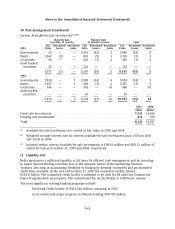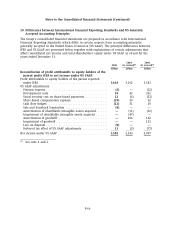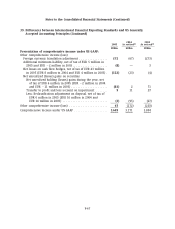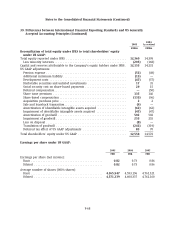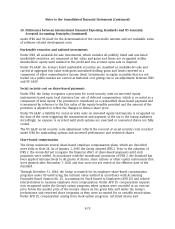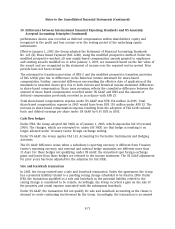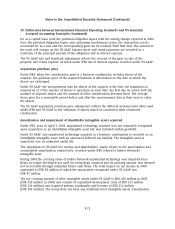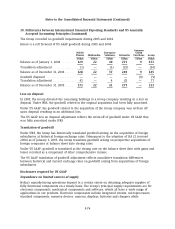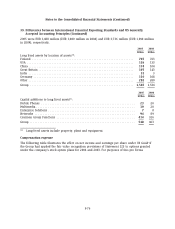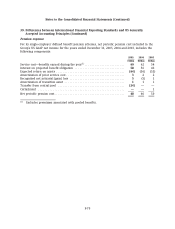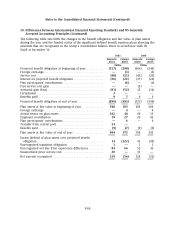Nokia 2005 Annual Report Download - page 209
Download and view the complete annual report
Please find page 209 of the 2005 Nokia annual report below. You can navigate through the pages in the report by either clicking on the pages listed below, or by using the keyword search tool below to find specific information within the annual report.Notes to the Consolidated Financial Statements (Continued)
39. Differences between International Financial Reporting Standards and US Generally
Accepted Accounting Principles (Continued)
performance shares was recorded as deferred compensation within shareholders’ equity and
recognized in the profit and loss account over the vesting period of the underlying equity
instruments.
Effective January 1, 2005, the Group adopted the Statement of Financial Accounting Standards
No. 123 (R), Share Based Payment (FAS 123R), using the modified prospective method. Under the
modified prospective method, all new equity-based compensation awards granted to employees
and existing awards modified on or after January 1, 2005, are measured based on the fair value of
the award and are recognized in the statement of income over the required service period. Prior
periods have not been revised.
The retrospective transition provision of IFRS 2 and the modified prospective transition provision
of FAS 123(R) give rise to differences in the historical income statement for share-based
compensation. Further, associated differences surrounding the effective date of application of the
standards to unvested shares give rise to both current and historical income statement differences
in share-based compensation. Share issue premium reflects the cumulative difference between the
amount of share based compensation recorded under US GAAP and IFRS and the amount of
deferred compensation previously recorded in accordance with APB 25.
Total share-based compensation expense under US GAAP was EUR 134 million in 2005. Total
share-based compensation expense in 2005 would have been EUR 110 million under APB 25. The
increase in share-based compensation expense resulting from the adoption of FAS 123R reduced
basic and diluted earnings per share under US GAAP by 0.01 EUR in 2005.
Cash flow hedges
Under IFRS, the Group adopted IAS 39(R) as of January 1, 2005, which supersedes IAS 39 (revised
2000). The changes, which are retrospective, under IAS 39(R) are that hedge accounting is no
longer allowed under Treasury Center foreign exchange netting.
Under US GAAP, the Group applies FAS 133, Accounting for Derivative Instruments and Hedging
Activities.
The US GAAP difference arises when a subsidiary’s reporting currency is different from Treasury
Center’s reporting currency and external and internal hedge maturities are different more than
31 days. For those hedges not qualifying under US GAAP, the unrealized spot foreign exchange
gains and losses from those hedges are released to the income statement. The US GAAP adjustment
for prior years has been adjusted for the adoption for IAS 39(R).
Sale and leaseback transaction
In 2005, the Group entered into a sale and leaseback transaction. Under the agreement, the Group
has a potential liability related to a pending zoning change scheduled to be final in 2006. Under
IFRS, the transaction qualified as a sale and leaseback as the potential liability related to the
zoning change is considered to be remote. Accordingly, the Group recorded a gain on the sale of
the property and rental expense associated with the subsequent leaseback.
Under US GAAP, the transaction did not qualify for sale and leaseback accounting as the clause is
deemed to create continuing involvement by the Group. Accordingly, the transaction is accounted
F-71




